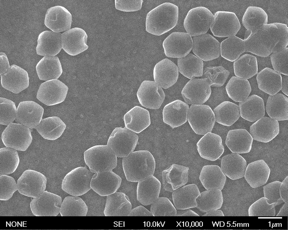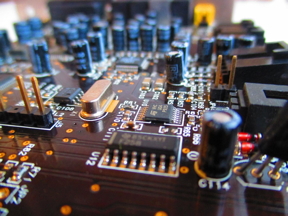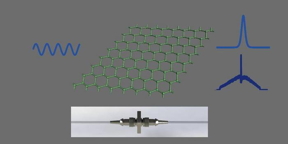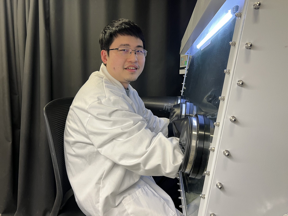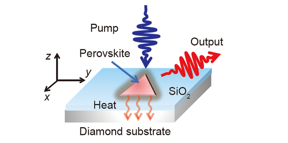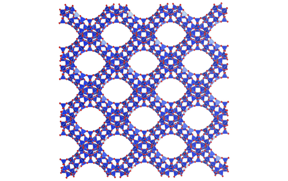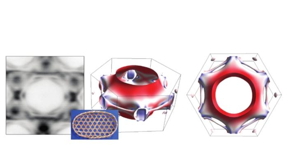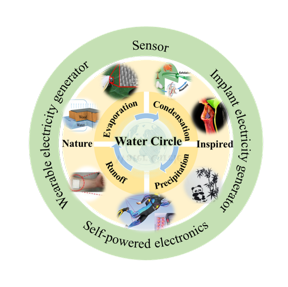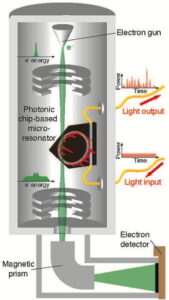Home > Press > Discovery made by University of Warsaw scientists may enable network interface for quantum computers
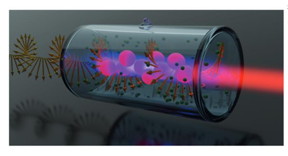 |
| Artist's impression of Rydberg atoms converting a microwave field into an optical beam (Source: M. Mazelanik, University of Warsaw) CREDIT M. Mazelanik, University of Warsaw |
Abstract:
A team of scientists at the QOT Centre for Quantum Optical Technologies, including a student from the Faculty of Physics (University of Warsaw), made a device capable of the conversion of quantum information between microwave and optical photons. The results of research, published in “Nature Photonics” magazine, highlight a new microwave detection method with possible applications in quantum technologies, as a part of quantum network infrastructure, and in microwave radio-astronomy.
Discovery made by University of Warsaw scientists may enable network interface for quantum computers
Warsaw, Poland | Posted on October 6th, 2023Conversion of quantum information
Whenever you listen to a song on your phone or computer, a conversion of information happens – a file digitally encoded in your device’s memory is converted to an electric current driving your headphones. Similarly, we can convert quantum information encoded in photons – the smallest quanta of light. For example, we can transfer information from a single microwave photon to a single optical photon. However, devices capable of single-photon operations are quite difficult to realise, because they need to be very precise and introduce very little noise. Additionally, what makes the task challenging is the fact that optical photons have energy ten thousand times larger than microwave photons and there are few media capable of simultaneously interacting with both species.
Still, the conversion of quantum information is pivotal to hybrid quantum networks – networks connecting different quantum devices, such as quantum computers. Quantum computing can be realised with microwave photons interacting with superconducting circuits, though the long-distance transfer of quantum information encoded in this manner poses a challenge due to the accumulation of noise. However, this is no longer a problem for optical photons, which can efficiently send quantum information via optical fibers. Therefore, the microwave-to-optical converter of quantum information can be a crucial part of a quantum network adapter – an interface between quantum computers and the quantum internet.
Enlarged atoms
One known medium that can interact both with microwave and optical photons are Rydberg atoms, named after Johannes Rydberg, who researched optical spectroscopy at the turn of the 19th century and stated the famous Rydberg formula. Rydberg atoms can be produced via laser excitation of valence electrons e.g. in rubidium atoms. This causes the atoms to increase their size a thousandfold and acquire many interesting properties, which are a hot research topic all over the scientific world. In this case, it is important to know that Rydberg atoms are very sensitive to microwave radiation.
So far, microwave-to-optical conversion has only been demonstrated in laser-cooled atoms caught in complex magneto-optical trapping setup. The scientists at the University of Warsaw are the first to show that microwave-to-optical conversion can be realised at room temperature, in atomic vapours inside a glass cell. The proposed design of the converter is notably simpler and can be further miniaturised in the future. Additionally, the new conversion scheme shows very low noise levels and therefore can perform operations even on single photons. Even though the new converter setup is much simpler, the parameters of the conversion are surprisingly better. In particular, the invention made at UW can work non-stop, as the atoms do not have to be prepared in a specially designed time sequence, which can take up more than 99% of the devices’ operational time in experiments done by other groups.
Using the converter device, the scientists at UW have demonstrated the detection of microwave thermal radiation at room temperature – for the first time it has been done without using microwave antennas or special low-noise amplifiers. To get to the thermal level, the device has to be sensitive to single photons, but nevertheless, the converter can work for microwave radiation a million times stronger and cannot be damaged with even stronger fields, in contrast to other standard microwave devices.
The future lies in microwaves
The rapidly developing quantum technologies use various information carriers. Quantum computers based on superconducting junctions store their information in microwave frequencies, whereas quantum memories are largely based on optical photons. Similarly to the quantum network adapter, the interconnection between the two types of devices requires an interface that can efficiently work both in microwave and optical domain. Rydberg atoms are being presented here as the solution.
Single-photon microwave operations will be important in astronomical observations researching the properties of distant bodies or the shape of the early universe via measurements of the cosmic microwave background. Until now, measurements retaining quantum information in microwave photons have not been possible and microwave-to-optical conversion may create a whole new branch of microwave radio-astronomy.
Everyday mass communication can also benefit from the discoveries in microwave detection. Next-gen mobile technologies are set to heavily utilise high frequency microwave transmission bands, difficult to emit and detect in conventional electrical circuits. One day, atomic microwave sensors may be a crucial part of high-speed internet connection. This is why in the Centre for Quantum Optical Technologies QOT, as well as in scientific institutes all over the world, there is ongoing research on how to employ quantum technologies in ultrasensitive microwave detection.
The published work was an effort made by the team of Sebastian Borowka, Uliana Pylypenko, dr. Mateusz Mazelanik and dr. hab. Michal Parniak – group leader of the Quantum Optical Devices Laboratory at the Centre for Quantum Optical Technologies QOT. The authors are all affiliated with the Faculty of Physics as students or alumni. Students and PhD students can participate in ongoing research at QOT and their findings may form a basis for their PhD, Master’s and Bachelor’s theses.
This research is a central result of the SONATA17 project funded by the National Science Centre. The “Quantum Optical Technologies” (MAB/2018/4) project is carried out within the International Research Agendas programme of the Foundation for Polish Science co-financed by the European Union under the European Regional Development Fund. The UW's Centre for Quantum Optical Technologies (hosted in CeNT – the Centre of New Technologies) is a research unit seeking practical applications of the latest discoveries in quantum optics.
####
About University of Warsaw, Faculty of Physics
Physics and astronomy at the University of Warsaw appeared in 1816 as part of the then Faculty of Philosophy. In 1825, the Astronomical Observatory was established. Currently, the Faculty of Physics at the University of Warsaw consists of the following institutes: Experimental Physics, Theoretical Physics, Geophysics, the Department of Mathematical Methods and the Astronomical Observatory. The research covers almost all areas of modern physics, on scales from quantum to cosmological. The Faculty's research and teaching staff consists of over 250 academic teachers. About 1,100 students and over 170 doctoral students study at the Faculty of Physics UW. The University of Warsaw is among the 75 best universities in the world educating in the field of physics according to the Shanghai’s Global Ranking of Academic Subjects.
For more information, please click here
Contacts:
Media Contact
Agata Meissner
University of Warsaw, Faculty of Physics
Office: 225-532-573
Expert Contact
Dr. Michal Parniak
QOT Centre for Quantum Optical Technologies, Centre of New Technologies, University of Warsaw
Office: +48 22 5543786
Copyright © University of Warsaw, Faculty of Physics
If you have a comment, please Contact us.Issuers of news releases, not 7th Wave, Inc. or Nanotechnology Now, are solely responsible for the accuracy of the content.
| Related Links |
| Related News Press |
News and information
![]() Observation of left and right at nanoscale with optical force October 6th, 2023
Observation of left and right at nanoscale with optical force October 6th, 2023
![]() The efficient perovskite cells with a structured anti-reflective layer – another step towards commercialization on a wider scale October 6th, 2023
The efficient perovskite cells with a structured anti-reflective layer – another step towards commercialization on a wider scale October 6th, 2023
![]() Super-efficient laser light-induced detection of cancer cell-derived nanoparticles: Skipping ultracentrifugation, detection time reduced from hours to minutes! October 6th, 2023
Super-efficient laser light-induced detection of cancer cell-derived nanoparticles: Skipping ultracentrifugation, detection time reduced from hours to minutes! October 6th, 2023
![]() Successful morphing of inorganic perovskites without damaging their functional properties October 6th, 2023
Successful morphing of inorganic perovskites without damaging their functional properties October 6th, 2023
![]() Interdisciplinary: Rice team tackles the future of semiconductors Multiferroics could be the key to ultralow-energy computing October 6th, 2023
Interdisciplinary: Rice team tackles the future of semiconductors Multiferroics could be the key to ultralow-energy computing October 6th, 2023
Quantum Physics
![]() Twisted science: NIST researchers find a new quantum ruler to explore exotic matter October 6th, 2023
Twisted science: NIST researchers find a new quantum ruler to explore exotic matter October 6th, 2023
Quantum communication
![]() IOP Publishing celebrates World Quantum Day with the announcement of a special quantum collection and the winners of two prestigious quantum awards April 14th, 2023
IOP Publishing celebrates World Quantum Day with the announcement of a special quantum collection and the winners of two prestigious quantum awards April 14th, 2023
![]() New experiment translates quantum information between technologies in an important step for the quantum internet March 24th, 2023
New experiment translates quantum information between technologies in an important step for the quantum internet March 24th, 2023
![]() Researchers demonstrate co-propagation of quantum and classical signals: Study shows that quantum encryption can be implemented in existing fiber networks January 20th, 2023
Researchers demonstrate co-propagation of quantum and classical signals: Study shows that quantum encryption can be implemented in existing fiber networks January 20th, 2023
Possible Futures
![]() The medicine of the future could be artificial life forms October 6th, 2023
The medicine of the future could be artificial life forms October 6th, 2023
![]() Successful morphing of inorganic perovskites without damaging their functional properties October 6th, 2023
Successful morphing of inorganic perovskites without damaging their functional properties October 6th, 2023
![]() Interdisciplinary: Rice team tackles the future of semiconductors Multiferroics could be the key to ultralow-energy computing October 6th, 2023
Interdisciplinary: Rice team tackles the future of semiconductors Multiferroics could be the key to ultralow-energy computing October 6th, 2023
Quantum Computing
![]() A new qubit platform is created atom by atom October 6th, 2023
A new qubit platform is created atom by atom October 6th, 2023
![]() Training quantum computers: physicists win prestigious IBM Award September 8th, 2023
Training quantum computers: physicists win prestigious IBM Award September 8th, 2023
![]() Machine learning contributes to better quantum error correction September 8th, 2023
Machine learning contributes to better quantum error correction September 8th, 2023
Discoveries
![]() Super-efficient laser light-induced detection of cancer cell-derived nanoparticles: Skipping ultracentrifugation, detection time reduced from hours to minutes! October 6th, 2023
Super-efficient laser light-induced detection of cancer cell-derived nanoparticles: Skipping ultracentrifugation, detection time reduced from hours to minutes! October 6th, 2023
![]() A new qubit platform is created atom by atom October 6th, 2023
A new qubit platform is created atom by atom October 6th, 2023
![]() Twisted science: NIST researchers find a new quantum ruler to explore exotic matter October 6th, 2023
Twisted science: NIST researchers find a new quantum ruler to explore exotic matter October 6th, 2023
![]() The medicine of the future could be artificial life forms October 6th, 2023
The medicine of the future could be artificial life forms October 6th, 2023
Announcements
![]() Observation of left and right at nanoscale with optical force October 6th, 2023
Observation of left and right at nanoscale with optical force October 6th, 2023
![]() The efficient perovskite cells with a structured anti-reflective layer – another step towards commercialization on a wider scale October 6th, 2023
The efficient perovskite cells with a structured anti-reflective layer – another step towards commercialization on a wider scale October 6th, 2023
![]() Super-efficient laser light-induced detection of cancer cell-derived nanoparticles: Skipping ultracentrifugation, detection time reduced from hours to minutes! October 6th, 2023
Super-efficient laser light-induced detection of cancer cell-derived nanoparticles: Skipping ultracentrifugation, detection time reduced from hours to minutes! October 6th, 2023
![]() A new qubit platform is created atom by atom October 6th, 2023
A new qubit platform is created atom by atom October 6th, 2023
Interviews/Book Reviews/Essays/Reports/Podcasts/Journals/White papers/Posters
![]() Observation of left and right at nanoscale with optical force October 6th, 2023
Observation of left and right at nanoscale with optical force October 6th, 2023
![]() The efficient perovskite cells with a structured anti-reflective layer – another step towards commercialization on a wider scale October 6th, 2023
The efficient perovskite cells with a structured anti-reflective layer – another step towards commercialization on a wider scale October 6th, 2023
![]() Super-efficient laser light-induced detection of cancer cell-derived nanoparticles: Skipping ultracentrifugation, detection time reduced from hours to minutes! October 6th, 2023
Super-efficient laser light-induced detection of cancer cell-derived nanoparticles: Skipping ultracentrifugation, detection time reduced from hours to minutes! October 6th, 2023
![]() A new qubit platform is created atom by atom October 6th, 2023
A new qubit platform is created atom by atom October 6th, 2023
- SEO Powered Content & PR Distribution. Get Amplified Today.
- PlatoData.Network Vertical Generative Ai. Empower Yourself. Access Here.
- PlatoAiStream. Web3 Intelligence. Knowledge Amplified. Access Here.
- PlatoESG. Carbon, CleanTech, Energy, Environment, Solar, Waste Management. Access Here.
- PlatoHealth. Biotech and Clinical Trials Intelligence. Access Here.
- Source: http://www.nanotech-now.com/news.cgi?story_id=57400
- :has
- :is
- :not
- $UP
- 1
- 10
- 100
- 20th
- 22
- 24th
- 250
- 27
- 27th
- 6th
- 75
- 7th
- 8th
- a
- About
- academic
- According
- accumulation
- accuracy
- acquire
- Additionally
- advancing
- adverse
- Affiliated
- After
- algorithms
- All
- almost
- also
- among
- an
- and
- Announcement
- Announces
- Another
- appeared
- applications
- April
- ARE
- areas
- artificial
- artist
- AS
- astronomy
- At
- atom
- authors
- background
- based
- basis
- BE
- Beam
- because
- been
- being
- benefit
- BEST
- Better
- between
- bodies
- both
- Branch
- BRIDGE
- but
- by
- CAN
- Cancer
- cannot
- capable
- carried
- carriers
- case
- caught
- causes
- celebrates
- cell
- Cells
- cent
- Center
- central
- centre
- Century
- CGI
- challenge
- challenging
- click
- collection
- COM
- comment
- commercialization
- Communication
- Complement
- complex
- computer
- computers
- computing
- Connecting
- connection
- consists
- content
- contrast
- contributes
- conventional
- Conversion
- convert
- converted
- converting
- could
- covers
- create
- created
- credit
- crucial
- Current
- Currently
- damaging
- day
- demonstrate
- demonstrated
- Department
- Design
- designed
- detect
- Detection
- developing
- Development
- device
- Devices
- different
- difficult
- digitally
- discovery
- Distant
- do
- domain
- done
- dr
- driving
- due
- e
- Early
- Early Universe
- educating
- effects
- efficient
- efficiently
- effort
- Electric
- electrons
- enable
- encryption
- end
- energy
- error
- established
- Ether (ETH)
- European
- european union
- Even
- example
- existing
- Exotic
- experiment
- experimental
- experiments
- explore
- fact
- famous
- far
- few
- fewer
- fibers
- field
- Fields
- File
- Find
- findings
- First
- first time
- following
- For
- form
- formula
- Foundation
- Frequency
- from
- functional
- fund
- funded
- further
- future
- generation
- get
- gif
- glass
- Global
- Group
- Group’s
- happens
- Harnessing
- Have
- headphones
- heavily
- here
- High
- Highlight
- hosted
- HOT
- HOURS
- How
- How To
- However
- http
- HTTPS
- Hybrid
- IBM
- if
- implemented
- important
- in
- Inc.
- Including
- Increase
- information
- Infrastructure
- inside
- interact
- interacting
- interconnection
- interesting
- Interface
- International
- Internet
- internet connection
- into
- introduce
- Invention
- IT
- January
- Key
- Know
- known
- laboratory
- largely
- larger
- laser
- latest
- layer
- leader
- learning
- left
- Level
- levels
- lies
- Life
- light
- links
- little
- longer
- Low
- made
- magazine
- make
- MAKES
- manner
- many
- March
- Mass
- master’s
- mathematical
- May..
- measurements
- Media
- medicine
- medium
- Memories
- Memory
- method
- methods
- million
- Mobile
- Modern
- more
- much
- Named
- nanotechnology
- National
- National Science
- Nature
- nearly
- Need
- net
- network
- networks
- Nevertheless
- New
- New technologies
- news
- nist
- no
- Noise
- notably
- now
- nuclear
- Nuclear physics
- observations
- observatory
- october
- of
- Offers
- on
- ONE
- ongoing
- only
- operational
- Operations
- optics
- or
- Other
- out
- over
- parameters
- part
- participate
- particular
- perform
- phd
- philosophy
- phone
- Photons
- PHP
- Physics
- pivotal
- platform
- plato
- Plato Data Intelligence
- PlatoData
- please
- Poland
- Polish
- poses
- possible
- Post
- posted
- potential
- Practical
- Practical Applications
- precise
- prepared
- presented
- press
- Press Release
- prestigious
- Problem
- Produced
- programme
- project
- projects
- promising
- properties
- proposed
- Publication
- published
- Publishing
- Quantum
- quantum computers
- quantum computing
- quantum information
- Quantum Internet
- quantum networks
- Quantum optics
- Quantum sensors
- Qubit
- qubits
- quite
- Radiation
- Ranking
- rapidly
- reactions
- reduce
- Reduced
- regional
- release
- Releases
- requires
- research
- researchers
- responsible
- result
- Results
- retaining
- return
- Rice
- right
- Room
- s
- safer
- Save
- scales
- scheme
- Science
- scientific
- scientists
- Search
- seeking
- Semiconductors
- send
- sensitive
- sensors
- September
- Sequence
- set
- setup
- Shape
- Share
- show
- Shows
- side
- signals
- Similarly
- simultaneously
- single
- Size
- solely
- solution
- song
- Source
- span
- special
- specially
- Spectroscopy
- Staff
- standard
- start
- stated
- States
- Step
- store
- Strategy
- stronger
- structured
- Student
- Students
- Study
- submit
- such
- Tackles
- Take
- Task
- teachers
- Teaching
- team
- Technologies
- ten
- than
- that
- The
- The Future
- the world
- their
- then
- theoretical
- There.
- therefore
- thermal
- they
- this
- though?
- thousand
- time
- times
- to
- topic
- towards
- transfer
- trapping
- TURN
- two
- types
- under
- union
- unit
- Universe
- Universities
- university
- until
- us
- use
- using
- various
- very
- via
- Warsaw
- was
- Wave
- we
- WELL
- What
- whereas
- which
- WHO
- whole
- why
- wider
- will
- win
- winners
- with
- within
- without
- Work
- world
- Yahoo
- you
- Your
- zephyrnet










